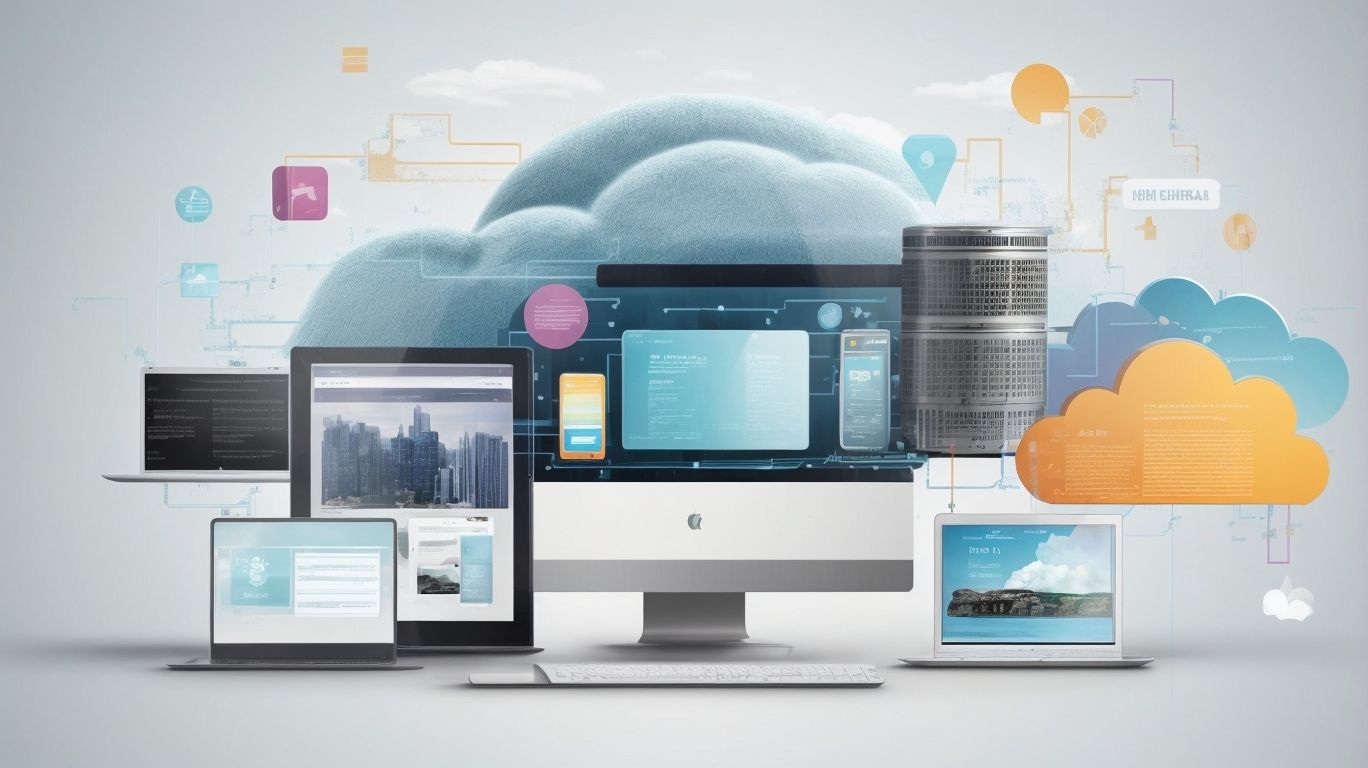Web technologies are constantly evolving, shaping the way we interact with the digital world. From artificial intelligence and machine learning to blockchain technology, the current trends in web technologies are revolutionizing the way we experience the internet.
But what about the emerging trends? The internet of things, chatbots, and 5G technology are just a few of the developments on the horizon. In this article, we’ll explore the potential impacts of these emerging trends, from improved user experience to potential ethical and social concerns. Stay tuned to discover the future of web technologies and the exciting developments to watch out for.
What Are Web Technologies?
Web Technologies encompass a wide range of tools, languages, and software used to build and maintain websites and web applications. They play a pivotal role in shaping the present online landscape and are poised to significantly influence the digital future.
The evolution of web technologies has led to the creation of dynamic and interactive web experiences, promoting seamless user interactions and personalized content delivery.
As the digital ecosystem continues to evolve, web technologies are anticipated to drive innovations in areas such as e-commerce, cloud computing, Internet of Things (IoT), and virtual/augmented reality (VR/AR), paving the way for a more connected and immersive online experience.
Embracing advancements in web technologies can lead to enhanced user engagement, improved accessibility, and streamlined business operations, fostering a more inclusive and efficient digital environment.
What Are The Current Trends In Web Technologies?
The current trends in web technologies encompass a diverse set of innovations and advancements that are reshaping digital experiences. From the integration of artificial intelligence and machine learning to the widespread adoption of progressive web apps and the immersive potential of augmented reality and virtual reality, these trends are actively shaping the present landscape of web technologies.
Artificial Intelligence and Machine Learning
Artificial Intelligence and Machine Learning are revolutionizing web technologies by enabling intelligent automation, personalized user experiences, and data-driven insights. Their integration is poised to shape the future of web technologies, offering unprecedented levels of innovation and efficiency, while also raising important considerations around data privacy and security.
Advanced technologies have the potential to streamline processes across various industries, from e-commerce to healthcare. By optimizing customer interactions and predicting user behavior, AI and machine learning are revolutionizing web development.
These advancements have led to the emergence of chatbots, recommendation systems, and dynamic content personalization, creating a more engaging and tailored online experience for users. Additionally, the continuous advancements in these fields present opportunities for enhanced cybersecurity measures, protecting sensitive data and mitigating potential risks associated with digital interactions.
Voice User Interfaces
Voice User Interfaces represent a transformative trend in web technologies, enabling hands-free interaction and seamless user experiences. Their integration not only enhances user convenience but also drives automation and efficiency, shaping the future landscape of web technologies.
The shift towards voice-based interaction signifies a fundamental change in how users engage with digital platforms. By utilizing natural language processing and artificial intelligence, Voice User Interfaces can understand and respond to user commands, making tasks more intuitive and accessible.
This shift has enormous potential to revolutionize the way we interact with technology, offering a glimpse into a future where voice commands drive automation and streamline user experiences across various web applications and services.
Progressive Web Apps
Progressive Web Apps represent a paradigm shift in web technologies, offering enhanced user experiences, seamless mobile optimization, and innovative features that bridge the gap between web and native applications.
Their future potential is poised to redefine the standards of web technology innovation. These apps utilize modern web capabilities to deliver app-like experiences, ensuring that users can access and interact with content even in offline mode. This seamless functionality not only enhances user experience but also contributes to increased user engagement and retention.
Progressive Web Apps are designed to be responsive and adaptive, enabling them to provide a consistent and optimized experience across various devices and platforms. By integrating advanced features such as push notifications and home screen installation, they further blur the distinction between web and native apps, driving innovation in the digital landscape.
Augmented Reality and Virtual Reality
The integration of Augmented Reality and Virtual Reality into web technologies is redefining user experiences, offering immersive and interactive interfaces that transcend traditional boundaries. Their potential to revolutionize the future of web technologies is anchored in their ability to create compelling and transformative digital experiences.
This enhanced technology provides users with a new dimension of interaction, allowing them to engage with digital content in ways that were previously unimaginable.
By seamlessly blending virtual elements with real-world environments, AR and VR open up endless possibilities for entertainment, education, and commerce. Their impact extends beyond novelty, as they drive future innovations in sectors ranging from e-commerce and architecture to healthcare and gaming.
As these technologies continue to evolve, they are poised to reshape the digital landscape and elevate user experiences to unprecedented levels.
Blockchain Technology
Blockchain Technology is at the forefront of web technology innovations, offering decentralized and secure solutions that have the potential to revolutionize data privacy and security.
Its impact on the future of web technologies extends to redefining digital trust and transparency.
Blockchain is a revolutionary technology that utilizes a distributed ledger system, eliminating the need for a central authority.
This decreases the risk of data manipulation and unauthorized access, fostering greater transparency and tamper-proof data records.
With its immutable and secure digital infrastructure, Blockchain has the potential to streamline processes across various industries, from finance to healthcare.
This opens the door for innovative applications beyond traditional data management systems.
What Are The Emerging Trends In Web Technologies?
The emerging trends in web technologies present a landscape of dynamic innovations that are poised to redefine digital experiences. From the expansive potential of the Internet of Things to the conversational capabilities of chatbots and the transformative impact of 5G technology and edge computing, these trends are shaping the next wave of web technologies.
Internet of Things (IoT)
The Internet of Things is a pivotal emerging trend in web technologies, heralding a new era of interconnected devices, intelligent automation, and innovative applications.
Its potential for transforming the digital landscape is anchored in its ability to drive automation, efficiency, and data security.
This interconnected network of physical devices, vehicles, appliances, and other items embedded with sensors, software, and network connectivity creates a seamless flow of data and communication.
It has paved the way for innovative applications such as smart homes, autonomous vehicles, and industrial automation. Alongside these advancements, the Internet of Things has also raised concerns about data security, prompting the development of more robust encryption and authentication protocols to safeguard sensitive information and maintain privacy.
Chatbots and Conversational Interfaces
Chatbots and Conversational Interfaces are reshaping web technologies by enabling natural language interactions, seamless user engagement, and automated assistance.
Their emerging prominence signifies a fundamental shift in user experiences and digital interactions. This transformation has profound implications across various industries.
The integration of chatbots and conversational interfaces fosters efficient customer support, facilitates quick access to information, and streamlines e-commerce transactions.
Their ability to learn from interactions and adapt to user preferences is driving innovation in personalized services and content delivery. By leveraging AI and machine learning, these technologies are enhancing the overall user experience and paving the way for more intuitive, human-like interactions on the web.
Edge Computing
Edge Computing is an emerging trend in web technologies that facilitates real-time data processing, low-latency interactions, and enhanced network efficiency. Its potential to complement the advancements of 5G technology positions it as a significant driver of digital innovations.
This distributed computing paradigm brings computation and data storage closer to the location where it is needed, reducing the need for data to travel to centralized cloud servers. This not only minimizes the processing time significantly but also minimizes the burden on the network infrastructure.
The seamless integration of edge computing with 5G technology holds the promise of empowering numerous applications, including autonomous vehicles, smart cities, and immersive augmented reality experiences.
5G Technology
The advent of 5G Technology is propelling web technologies into a new era of high-speed connectivity, enhanced mobile optimization, and transformative network capabilities. Its emergence signifies a paradigm shift in the digital landscape, offering unparalleled opportunities for innovation and seamless experiences.
This revolutionary technology promises to revolutionize the way we interact with the internet, enabling faster download and upload speeds, lower latency, and greater bandwidth.
As a result, web developers and businesses are presented with the chance to create and deliver high-quality, immersive content, such as virtual and augmented reality experiences, that were previously hindered by slower network speeds.
The potential for mobile optimization is vast, as 5G will enable seamless streaming, faster loading times, and improved user experiences across various devices.
As networks become more robust, cloud computing, IoT, and edge computing will also flourish, leading to a new wave of transformative innovations.
Cybersecurity and Data Privacy
Cybersecurity and Data Privacy are critical emerging trends in web technologies, shaping a landscape of secure digital experiences and automated threat management. Their significance and impact extend to safeguarding user data, fostering digital trust, and driving innovations in security practices.
In today’s rapidly changing digital world, protecting sensitive information and preventing cyber threats is crucial. Robust cybersecurity measures not only safeguard valuable assets, but also instill confidence in online interactions. With the rise of data privacy regulations and advancements in encryption techniques, the resilience of digital ecosystems is being enhanced. The ongoing evolution of cybersecurity technologies is revolutionizing data protection, empowering organizations to effectively adapt and respond to constantly evolving threats.
What Are The Potential Impacts Of These Emerging Trends?
The emerging trends in web technologies hold the potential to significantly impact digital experiences, automation, data security, business opportunities, and ethical considerations. Their influence spans the realms of user-centric developments, enhanced efficiency, and the broader ethical and societal implications of technological advancements.
Improved User Experience
The emerging trends in web technologies are poised to elevate user experiences through enhanced interactivity, personalized engagements, and intuitive interfaces.
Their impact is set to redefine the benchmarks for user-centric developments and digital interactions.
This evolution in web technologies holds the potential to revolutionize the way users interact with digital platforms.
With the integration of AI and machine learning, websites and applications can adapt to users’ behavior, delivering personalized content and experiences.
The rise of augmented and virtual reality is opening new dimensions for immersive and engaging interfaces, offering unprecedented opportunities for businesses to connect with their audience in innovative ways.
These trends are shaping a digital landscape where user experiences are not just enriched but are also tailored to individual preferences, setting new standards for user engagement and satisfaction.
Increased Automation and Efficiency
The emerging trends in web technologies herald a new era of automation and efficiency, streamlining processes, and optimizing digital workflows.
Their potential to drive transformative efficiencies signifies a fundamental shift in the digital landscape.
The constant evolution of web technologies is revolutionizing the way businesses function. With the incorporation of artificial intelligence and machine learning, web development is becoming more efficient. This shift allows for the automation of mundane tasks like data entry and content management, freeing up resources for more critical tasks.
Integrating these advanced technologies into web platforms leads to enhanced user experiences and increased customer engagement. This ultimately drives operational efficiencies and helps businesses achieve digital success.
Enhanced Data Security and Privacy
The emerging trends in web technologies are pivotal in fortifying data security and privacy, offering innovative solutions and practices that safeguard user information and digital assets. Their potential to enhance trust and transparency signifies a critical advancement in digital ethics and practices.
The future of security measures is being shaped by various trends, such as advanced encryption techniques, multi-factor authentication, and biometric security protocols. These trends also promote the use of artificial intelligence and machine learning to detect and prevent cyber threats, making digital infrastructure more resilient. Additionally, these trends prioritize user privacy and data protection, revolutionizing the approach to security and instilling confidence in consumers. This continual innovation in safeguarding sensitive information is crucial for organizations.
Expanded Business Opportunities
The emerging trends in web technologies present an array of expanded business opportunities, enabling innovation, digital transformation, and new avenues for growth and development.
Their potential to reshape the business landscape signifies a transformative shift in economic and entrepreneurial opportunities.
These trends are fostering a dynamic environment where businesses can leverage cutting-edge tools and platforms to enhance their online presence, customer experiences, and operational efficiency.
The evolution of web technologies opens doors for disruptive ideas and business models, facilitating the emergence of new market segments and revenue streams.
This shift also encourages collaboration and co-creation, paving the way for cross-industry partnerships and synergies that drive collective growth.
Potential Ethical and Social Concerns
The emerging trends in web technologies raise important ethical and social concerns related to data privacy, automation, and the broader societal impact of technological advancements. Their potential to engender ethical dilemmas and societal shifts signifies the need for critical discourse and responsible innovation.
As these trends continue to evolve, the implications for data privacy become increasingly complex, affecting individuals, organizations, and policymakers. The growing integration of automation in web technologies poses challenges in ensuring fair labor practices and addressing potential job displacement. These advancements have the power to reshape societal norms and interactions, compelling us to consider the wider implications for human relationships, communication, and community dynamics.
Frequently Asked Questions
What are some emerging trends to watch for in the future of web technologies?
Some emerging trends to watch for include artificial intelligence, blockchain technology, augmented reality, and the Internet of Things.
How will artificial intelligence impact the future of web technologies?
Artificial intelligence, or AI, is expected to play a major role in shaping the future of web technologies. It can help improve user experience, personalize content, and automate tasks for businesses.
What is blockchain technology and how will it affect the future of web technologies?
Blockchain technology is a digital ledger that records transactions across multiple computers. It has the potential to revolutionize how data is stored and shared on the web, making it more secure and transparent.
What role will augmented reality play in the future of web technologies?
Augmented reality, or AR, is the integration of digital information into the user’s environment in real time. It has the potential to enhance user experience on websites by creating immersive and interactive content.
How will the Internet of Things impact the future of web technologies?
The Internet of Things, or IoT, refers to the interconnection of everyday objects via the internet. In the future, web technologies will be able to communicate with and control these objects, making our lives more efficient and convenient.
What are the potential benefits of these emerging trends for businesses and consumers?
These emerging trends have the potential to improve efficiency, enhance user experience, and create new opportunities for businesses. For consumers, they can make web interactions more personalized and convenient.






